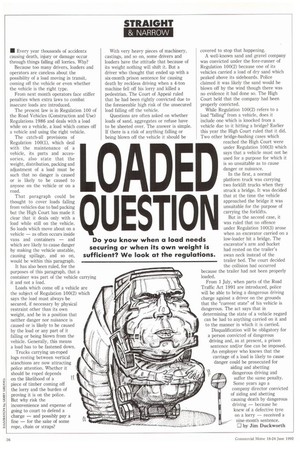• Every year thousands of accidents causing death, injury or damage occur through things falling off lorries. Why?
Page 28

If you've noticed an error in this article please click here to report it so we can fix it.
Because too many drivers, loaders and operators are careless about the possibility of a load moving in transit, coming off the vehicle or even whether the vehicle is the right type.
From next month operators face stiffer penalties when extra laws to combat insecure loads are introduced.
The present law is in Regulation 100 of the Road Vehicles (Construction and Use) Regulations 1986 and deals with a load while on a vehicle, a load which comes off a vehicle and using the right vehicle.
The catch-all provisions of Regulation 100(1), which deal with the maintenance of a vehicle, its parts and accessories, also state that the weight, distribution, packing and adjustment of a toad must be such that no danger is caused or is likely to be caused to anyone on the vehicle or on a road.
That paragraph could be thought to cover loads falling from vehicles due to bad packing but the High Court has made it clear that it deals only with a load while still on the vehicle. So loads which move about on a vehicle — as often occurs inside vans and containers — and which are likely to cause danger by making the vehicle unstable, causing spillage, and so on, would be within this paragraph.
It has also been ruled, for the purposes of this paragraph, that a container was part of the vehicle carrying it and not a load.
Loads which come off a vehicle are the subject of Regulation 100(2) which says the load must always be secured, if necessary by physical restraint other than its own weight, and be in a position that neither danger nor nuisance is caused or is likely to be caused by the load or any part of it falling or being blown from the vehicle. Generally, this means a load has to be fastened down.
Trucks carrying un-roped logs resting between vertical stanchions are now attracting police attention. Whether it should be roped depends on the likelihood of a piece of timber coming off the lorry and the burden of proving it is on the police. But why risk the
inconvenience and expense of going to court to defend a charge — and possibly pay a fine — for the sake of some rope, chain or straps? With very heavy pieces of machinery, castings, and so on, some drivers and loaders have the attitude that because of its weight nothing will shift it, But a driver who thought that ended up with a six-month prison sentence for causing death by reckless driving when a 4-ton machine fell off his lorry and killed a pedestrian. The Court of Appeal ruled that he had been rightly convicted due to the foreseeable high risk of the unsecured load falling off the vehicle.
Questions are often asked on whether loads of sand, aggregates or refuse have to be sheeted over. The answer is simple. If there is a risk of anything falling or being blown off the vehicle it should be covered to stop that happening.
A well-known sand and gravel company was convicted under the fore-runner of Regulation 100(2) because one of its vehicles carried a load of dry sand which peaked above its sideboards. Police claimed it was likely the sand would be blown off by the wind though there was no evidence it had done so. The High Court held that the company had been properly convicted.
While Regulation 100(2) refers to a load "falling" from a vehicle, does it include one which is knocked from a vehicle due to it hitting a bridge? Earlier this year the High Court ruled that it did. Two other bridge-bashing cases which reached the High Court were under Regulation 100(3) which says that a vehicle must not be used for a purpose for which it is so unsuitable as to cause danger or nuisance.
In the first, a normal platform truck was carrying two forklift trucks when they struck a bridge. It was decided that at the time the vehicle approached the bridge it was unsuitable for the purpose of carrying the forklifts.
But in the second case, it was ruled that no offence under Regulation 100(3) arose when an excavator carried on a low-loader hit a bridge. The excavator's arm and bucket had rested on the trailer's swan neck instead of the trailer bed. The court decided the collision had occurred because the trailer had not been properly loaded.
From 1 July, when parts of the Road Traffic Act 1991 are introduced, police will be able to bring a dangerous driving charge against a driver on the grounds that the "current state" of his vehicle is dangerous. The act says that in determining the state of a vehicle regard can be had to anything carried on it and to the manner in which it is carried, Disqualification will be obligatory for a person convicted of dangerous driving and, as at present, a prison sentence and/or fine can be imposed. An employer who knows that the carriage of a load is likely to cause danger could be prosecuted for
aiding and abetting dangerous driving and suffer the same penalty. Some years ago a company director convicted of aiding and abetting causing death by dangerous driving — because he knew of a defective tyre on a lorry — received a
nine-month sentence.
ILI by Jim Duckworth




















































































